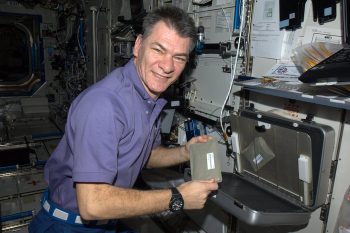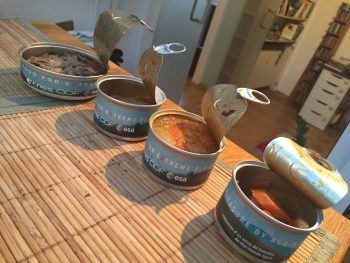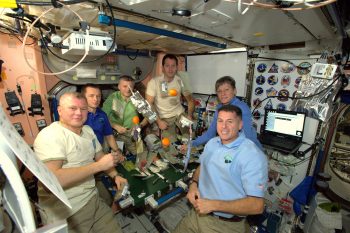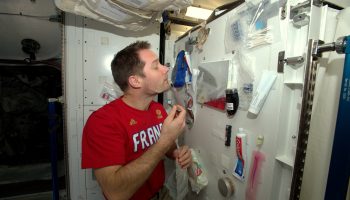How and what do we eat in space ? What does the “space food” consumed by astronauts during their six months on the International Space Station taste like? In his latest video from the International Space Station, ESA astronaut Thomas Pesquet answered some of these questions. Here are some additional explanations.
The conditions and constraints of weightlessness

ESA astronaut Paolo Nespoli using the American food warmer in 2011. Credits: ESA/NASA-Thomas Pesquet
Unsurprisingly, space food must meet the many constraints of life in weightlessness. The cooks and suppliers must comply with drastic hygiene measures and select products that will not cause problems in the Station’s confined environment. Crumbling bread is to be avoided: crumbs could float around and clog equipment. ESA astronaut Tim Peake’s bacon sandwich, prepared by star chef Heston Blumenthal, managed to pass the test after multiple attempts, but it was an exception – bread is scarce on the Space Station, tortillas are more practical in space. Food must also be stored at room temperature from 18–24 months, taking into account the long period of time that may elapse between production on Earth and consumption at the end of a space mission. Size is another constraint: it has to be possible for cans and bags to fit in the Station’s reheating system. The weight has to be taken into account too, in order to maximise the cost of sending cargo vehicles into space. Finally, the dishes must of course be balanced and adapted to the weight and the particular needs of each astronaut.
There are three main ways to conserve food in orbit. Thermo-stabilization destroys unwanted micro-organisms through heat and pressure and packages the dishes in the form of preserves, tubes or sachets, the latter being particularly sought-after by NASA. Before consumption, the astronauts place the containers in the heating system located in the Russian segment or the small bags between the heating plates of the American part of the Station. When using the lyophilisation process, which consists of freeze-drying food, simply rehydrating the contents of the pockets of food with hot water will allow the food to be eaten. Some foods, like nuts, are irradiated with ionising radiation before being sent into space.
Nourriture en boîte, ou en tube? Dégustation des plats Russes / Canned food, or in a tube? Russian food tasting today pic.twitter.com/xSZSM0S2Fe
— Thomas Pesquet (@Thom_astro) July 27, 2015
A last condition before packing the food and sending it to space with a cargo spacecraft: it must be relatively … tasty! It is not only a source of energy for astronauts but also a real psychological support. Space missions are increasingly long, so the taste of the dishes is no longer just a detail. In terms of storage conditions, there is no fresh produce on board the International Space Station, except for when a cargo vehicle brings fresh fruit along with its other cargo.
Bonus food and the psychological aspect

Cans prepared by Alain Ducasse and the CADMOS (CNES’ laboratory). Credits: Thomas Pesquet
With each new flight, astronauts take advantage of the lessons learnt from previous missions. These have highlighted the importance of nutrition as a psychological support. Over the last decade, space agencies have become increasingly interested in this issue. In addition to the daily food provided by NASA and Russian space agency Roscosmos, the astronauts each have “bonus” food that they choose for themselves. This represents about 10% of their total provisions, the equivalent of nine food containers. These can be snacks or in Thomas’ case, dishes prepared by chef Alain Ducasse in collaboration with French space agency CNES which delivers food to ISS astronauts on a regular basis, both French and international ones. This programme is also an opportunity for the CNES to propose nutrition experiments.
The European Space Agency has set up a collaboration with star-studded chefs in order to offer food specifically produced for the space missions of its European astronauts. Since Luca Parmitano’s spaceflight in 2013, each astronaut has worked with a great cook from their own country to develop meals that remind them of their childhood or their favourite dish on earth. After several meetings and exchanges with Thomas, star chef Thierry Marx concocted a New Year’s dinner with French flavours. Thomas was entitled to a tasting in France before his departure, though the food produced for space does not have the same taste on Earth as it does in orbit. Weightlessness redirects blood and other fluids to the top of the body obstructing astronauts’ sinuses. Olfactory capacities in particular, and with them the perception of flavours, are altered. To enhance the dishes, space food often has more salt than average. Astronauts can add salty liquid or pepper oil, available in the kitchen of the Station. The quantity of these seasonings is of course monitored to respect the balance of the nutritional intakes of the astronauts.
Festive meals and New Year’s Eve

Thanksgiving 2016 with the whole crew. Credits: ESA/NASA
What could be better than a good dinner to reunite the crew and celebrate events in a good mood, despite being away from one’s family? Thomas is in charge of the New Year’s meal and he will provide the food he ‘designed’ with chef Thierry Marx.

Cans prepared by chef Thierry Marx for New Year’s Eve. Credits: ESA
From time to time, astronauts share some of their bonus food, especially during so-called “event” meals (birthdays, departure or arrival of crew, end-of-year celebrations and so on). This is the case for Peggy Whitson and Thomas during their end-of-year holiday: they have both chosen to take a meal for the six astronauts of the station along in their personal reserve for Christmas and New Year’s eve. What’s on the menu you ask? Ox-tongue as an appetiser, chicken breasts with mushrooms and white wine sauce as a main course and to top it off, gingerbread for dessert! After the Italian, German, Danish and British gastronomies were savoured by his colleagues of the class of 2009 in recent years, the French cuisine will be honoured on 31 December.
It's a good thing that French food will settle this dispute once and for all 😉 #Proxima #SpaceFood @astro_luca @Astro_Andreas
— Thomas Pesquet (@Thom_astro) January 28, 2016





Discussion: 4 comments
It is appropriate time to make a few plans for the long run and it is time to
be happy. I’ve read this post and if I could I desire to
counsel you few fascinating issues or suggestions.
Maybe you can write next articles relating to this article.
I desire to learn even more things approximately it!
bonjour Thomas,
Je m’appelle Thomas Schuhl jl.
Je suis actuellement en première S et dans le cadre de mon TPE pour le lycée d’Orsay de Blaise Pascal je souhaiterais savoir si il serais possible d’échanger avec vous afin d’avoir une interview et de récolter d’autres informations qui pourraient nous aider à peaufiner notre travail.
Le sujet du TPE est l’eau dans la station spatiale internationale et si vous pouviez nous apprendre des choses en relation avec ce sujet cela nous serait d’une grande aide
Je vous remercie par avance et vous souhaite une bonne année 2017
Thomas SCHUHL
L’eau est liquide?
Bonjour , nous organisons un téléthon à Thionville sur le thème de “la conquête de Mars pour vaincre la maladie”nous aimerions nous procurer des repas d’astronaute. Pouvez vous nous aider? Cordialement Daniel